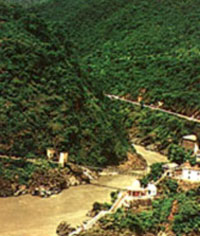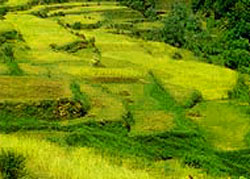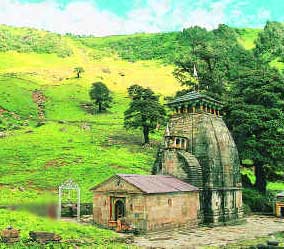| Trekking
Madhyamaheshwar: Reaching Shiva's Navel |
|||||
It was the Himalayas yet again. Something about the Garhwal region of the Himalayas draws me to its unspoiled and almost mystical environs time and again. The idea of our latest Himalayan adventure originated from a casual tea shop tete-e-tete about 2 years back at Gaurikund, the base station for the beautiful Kedarnath trek. We learnt that Madhyamaheshwar was the most scenic and picturesque of the Panch Kedar. As legend goes, after the war of the Mahabharat, the Pandavas, guilty of gotra hatya (killing of their kinsmen), decided to pay homage to Lord Shiva. Seeing the Pandavas coming , the Lord disguised himself as a bull. The Pandavas saw through Shiva's disguise. Realising that his disguise had not worked, the bull tried to plunge himself beneath the ground. Bhima swiftly held the hind legs of the bull, thus preventing it from vanishing. In the struggle that ensued different parts of Lord Shiva's body appeared at various places in Kedarkhand. With the forehead showing up at Pashupatinath in Kathmandu; the hump of the bull appeared at Kedarnath; the torso including the navel at Madhyamaheshwar; the arms at Tungnath; the face at Rudranath and the matted hair of Shiva at Kalpeshwar or Kalpnath. |
More on Uttarakhand • Overview • Char Dham
Trekking
Travelogues
Photo Gallerys
Sacred Space
Travelogues | ||||
Mansuna is the ideal base for the trip to Madhyamaheshwar. After a good nights sleep at the Chaukhamba hotel, we woke early to views of the distant Chaukhamba peaks. After a meal of aloo parathas at Ganga restaurant, where we employed Nandan Singh, our porter cum guide, we set off on a 2 km short-cut to Jugasu , 5 kms from Mansuna. A little ahead, the Nath river, originating at Tungnath, meets the Madhyamaheshwar Ganga, that we will be tracing through the next 4 days.
At Ransi, we watch the light drizzle, followed by a glorious rainbow, as we eat a good lunch at another Chaukhamba Hotel, and set off for Gondhar. The scenery is breathtaking with some 10 - 15 waterfalls en route. After about 6 kms of descent, we painstakingly climbed the remaining km to reach Gondhar at dusk . Our guide arranged our stay at a villagers home, which had solar powered electricity. We woke next morning to the sound of the gushing waters of the Madhyamaheshwar Ganga flowing a few meters below. After a breakfast of Maggi & milk, we started the second day of the trek . Our target was to cover 10 kms and an elevation of 1.5 kms. Half a km from Gondhar, is the confluence of the rivers Chaukhamba and Madhyamaheshwar Ganga. The scenery was beautiful and wild but a mere precursor of the picturesque mountainscape to follow beyond Bantoli, officially under the aegis of the forest department. Walking through the Kedarnath Wildlife Sanctuary, a part of one of the world's richest biosphere reserves, our next halt in the day's ascent is at Khatara. After a cup of hot coffee at the solitary hut here, we were joined by a couple of Garhwali gentlemen from Dehradun, headed for Nandi Kund , a celestial lake about 20 kms further up from Madhyamaheshwar. From Khatara, we maneuver the steep, rocky climb of 2 kms in 2 hours to reach Nanu at 2100 metres. After lunch we climb another 1,200 m over 5 and a half kms to cover the most beautiful terrain on the trek. The valley here is incredibly narrow and steep, providing breathtaking views of the opposite side of the canyon, tree and shrub lined all the way to the top.
We caught up with Nandan Singh at the next trace of civilization - a
solitary hut at Makhouma, midway between Nanu and Madhyamaheshwar.
In the late afternoon, early evening, we spotted wild fowl, glimpsed the hitherto elusive snow capped peaks on the other side of the valley, saw a passing mountain snake, possibly a Himalayan Pit Viper, and enjoyed the variety of mountain flowers and dense oak and deodar forests. At 7 pm , we could see our guide waiting for us at the end of the ridge, where the outline of a cluster of huts marked the end of the road.
Next morning, we woke early to walk up the gentle mountain slope, with it's incredible valley of flowers. Since it was mid August , the buds had just begun to flower. We could easily extrapolate the floral beauty of the valley once the entire slope were in abundant bloom, another two weeks later. Reportedly, there are over 100 species of wild flowers that are found here. After an ascent of some three fourths of a kilometer, the snow peaked caps of the majestic Chaukhamba suddenly appeared. The clouds played hide and seek so we could view the four peaks only intermittently. Further up we were greeted by the beatific sight of a lake on top of the mountain, called Budha Maheshwar. The view of the snow capped Chaukhamba and its reflection in the lake is simply mind blowing. Thereafter, we returned to offer puja at the temple to the chanting of mantras by the priest.
The priest at the Madhyamaheshwar shrine is from the Rawal sect of Brahmins, who have traditionally been the Pujaris here. We were not allowed into the inner sanctum, but could see the bronze idol of Lord Shiva. After a hearty brunch we bid farewell to the Lord's navel to return the next evening to Jugasu, after a night halt at Gondhar.
Returning to Delhi to reminisce, I remember these lines:
|
|||||
Editor: Romola Butalia (c) India Travelogue. All rights reserved. |
|||||
 There are 2 seasons to undertake this adventure - the 3 summer months and the 2 post monsoon months. After Diwali, till about advent of summer, the temple is inaccessible due to snow. During this period, the
Shiva idol is worshipped at Ukhimath. We reached Haridwar on Independence Day. From here, it took us 4 hours by jeep to Srinagar, the erstwhile capital of Pauri Garhwal. Thereafter, after a couple of jeep hops, we reached Mansuna, via Rudraprayag and Ukhimath.
There are 2 seasons to undertake this adventure - the 3 summer months and the 2 post monsoon months. After Diwali, till about advent of summer, the temple is inaccessible due to snow. During this period, the
Shiva idol is worshipped at Ukhimath. We reached Haridwar on Independence Day. From here, it took us 4 hours by jeep to Srinagar, the erstwhile capital of Pauri Garhwal. Thereafter, after a couple of jeep hops, we reached Mansuna, via Rudraprayag and Ukhimath.
 After crossing the Jugasu bridge, we pass women carrying headloads of hay, an occasional sight on the way. After a steep climb over mostly rocky terrain for about 1.5 km , we reached Raonli, Nandan Singh's village, where some 350 families apparently reside, though to the casual glance, only some 15-20 village huts are visible. We pass terraced farms and skirting the village of Uniana, at 3:30 p.m., having covered the 6 km distance from Jugasu we reach Ransi, 1400 m above sea-level. In 1998, a terrible landslide buried several villages, killing many people and livestock, uprooting trees and homes and leaving barren hillsides and tragedy in its wake.
After crossing the Jugasu bridge, we pass women carrying headloads of hay, an occasional sight on the way. After a steep climb over mostly rocky terrain for about 1.5 km , we reached Raonli, Nandan Singh's village, where some 350 families apparently reside, though to the casual glance, only some 15-20 village huts are visible. We pass terraced farms and skirting the village of Uniana, at 3:30 p.m., having covered the 6 km distance from Jugasu we reach Ransi, 1400 m above sea-level. In 1998, a terrible landslide buried several villages, killing many people and livestock, uprooting trees and homes and leaving barren hillsides and tragedy in its wake.
 Finally reaching our destination, we discovered that the evening Puja had been completed half an hour ago and we would have to wait till the next day to perform the rituals and receive prasad. We stayed overnight at the lodgings provided by the Mandir Samiti. We braved the cold, tended to our aching limbs, warmed ourselves by the earthern oven at one of the nearby huts converted into a 'hotel', where we ate our evening meal, ravenously hungry and completely exhausted. We watched the moonlit temple against the backdrop of the huge but gentle mountain slope on one side and the pitch dark mountain behind, keenly aware of the sounds of the Madhyamaheshwar Ganga.
Finally reaching our destination, we discovered that the evening Puja had been completed half an hour ago and we would have to wait till the next day to perform the rituals and receive prasad. We stayed overnight at the lodgings provided by the Mandir Samiti. We braved the cold, tended to our aching limbs, warmed ourselves by the earthern oven at one of the nearby huts converted into a 'hotel', where we ate our evening meal, ravenously hungry and completely exhausted. We watched the moonlit temple against the backdrop of the huge but gentle mountain slope on one side and the pitch dark mountain behind, keenly aware of the sounds of the Madhyamaheshwar Ganga.